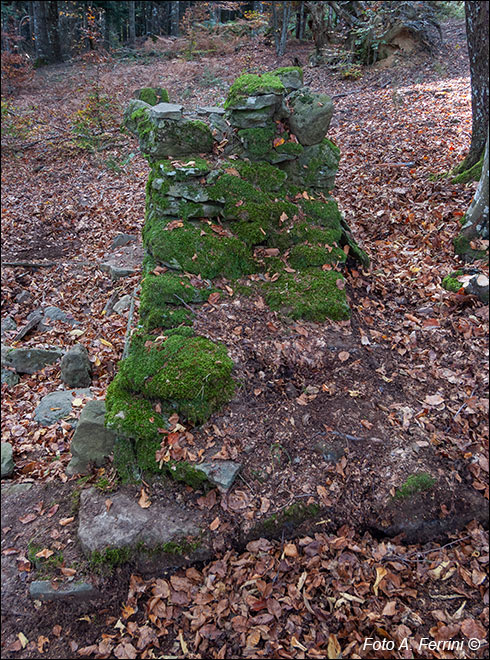Dal Varco di Anciolina a Badia Santa Trinita
itinerario da Pontenano all'abbazia benedettina di Santa Trinita e al Varco di Anciolina
Italiano
NATURA E STORIA PRESSO BADIA SANTA TRINITA 15
Lo stesso muro della pagina precedente, ora visto di profilo. Ha una sezione di 75 centimetri. È indubbio che siamo in presenza di un edificio che fu qualcosa di ben più importante di una capanna di un pastore o di un carbonaio. E allora cosa sarà stata in origine questa costruzione? Difficile dirlo, forse degli scavi ci svelerebbero qualcosa in più. Per il momento godiamoci la bella suggestione che alcuni inconfutabili elementi fanno scaturire in noi. Siamo accanto alla zona segnata Badia Vecchia nella attuale mappa catastale, i locali cercatori di funghi chiamano questo luogo Badivecchia, il manoscritto che tratta la fondazione di Santa Trinita parla di un sito precedente all'attuale (probabilmente molto piccolo e utilizzato per pochi anni), i ruderi che stiamo osservando sono certamente appartenuti ad un "edificio nobile".
The same wall as on the previous page, now seen in profile. It has a section of 75 centimeters. There is no doubt that we are in the presence of a building that was something much more important than a shepherd's hut or a charcoal burner's hut. So what was this construction originally? It is difficult to say, perhaps excavations would reveal something more. For the moment, let's enjoy the beautiful suggestion that some irrefutable elements bring out in us. We are next to the area marked Badia Vecchia in the current cadastral map, the local mushroom hunters call this place Badivecchia, the manuscript that deals with the foundation of Santa Trinita speaks of a site prior to the current one (probably very small and used for a few years), the ruins we are observing certainly belonged to a "noble building".























































































